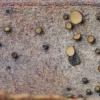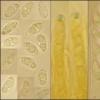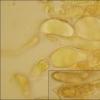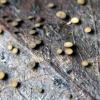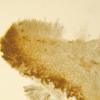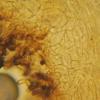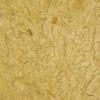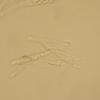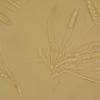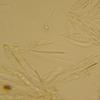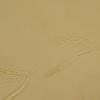
30-12-2025 16:44
Pascal DucosBonjour,Une anamorphe rose stipitée, très nombre

30-12-2025 17:14
 Bernard CLESSE
Bernard CLESSE
Bonjour à toutes et tous,Pourriez-vous aider Albe

29-12-2025 10:15
Hulda Caroline HolteHello, I found and collected this propoloid ascom

30-12-2025 09:04
Hello.A Pyrenomycete sprouting sparsely but very d

29-12-2025 17:44
Isabelle CharissouBonjour,J'aimerais savoir si d'autres personnes au

12-11-2021 00:03
Lepista ZacariasHi everybody,A week ago in my fiels trip I noticed

29-12-2025 17:12
 Bernard CLESSE
Bernard CLESSE
Bonjour à toutes et tous,Pourriez-vous m'aider à
Salut à tous,
Yesterday I found many apothecia of this interesting species on fallen leaves of Camellia japonica They measure up to 1.8 mm and had short stalks (up to 1mm). They were present on almost every leaf I inspected.
Asci IKI BB, croziers not observed (despite intense searching...)
Ascospores 9.8 - 11.9 x 5 - 6 µm, usually with two very large guttules and several smaller ones, with delicate sheaths which quickly disappear in water.
Paraphyses with a long, continuous vacuole (as in Mollisia)
Flank cells often with brown encrustation, and with large refractive vacuoles which quickly collapse and turn brown.
My specimen seems quite close to R.'kalevi' , though the ascospore dimensions are just a little different, as is the guttulation (and substrate). I'll come back later with some photos of ascus bases.
Am I thinking along the right lines? Has anyone collected anything similar on Camellia?
Amitiés,
Nick

this is just an idle thought - I'm sure others will prove far more knowledgeable - but those spores remind me of those of Trochila spp.
best wishes
Chris

I have no idea what species it could be - Camellia is a substrate not growing in Central Europe. But I think it is a Sclerotiniaceae because of the type of apical apparatus. And - yes - why not Rutstroemia? The spores are fully guttulate and elongate, and the macroscopical appearance could fit.
Regards from Lothar

what an interesting species! I see that I do not have any asco on Camellia leaves in my database, and I have no idea of the species. Rutstroemia is a good option. What shape do the excipular cells have? A photo would be useful, also if there is any gel layer.
Is it a park where you collected the fungus?
Zotto
Hi all,
Amazing Kutsuna! - I had hoped that this fungus was known in Japan!
I saw a few old light brown spores and your macroscopy and spore size fit well with mine. I don't suppose you found a name?
Zotto - Yes, a park/public garden. There is no gel - The third photo shows the area directly below the hymenium - Sorry but the anatomical teminology escapes me :)
Hopefully you agree that the ascus bases have no croziers (I found the photography tricky here!). Sometimes the ascogenus cells have little 'bulges' but I never saw these reach up to make a 'full' crozier.
Best wishes and apologies for the many photos,
Nick

So we should know quite enough about this species - maybe Japanese workers (Tsuyoshi Hosoya, Yanjie Zhao) could help? I will send them a link.
Zotto



